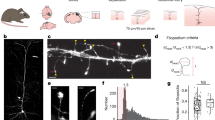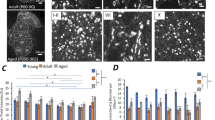Abstract
Postembedding immunogold labeling was used to determine the relationship between AMPA and NMDA receptor density and size of Schaffer collateral–commissural (SCC) synapses of the adult rat. All SCC synapses expressed NMDA receptors. AMPA and NMDA receptors were colocalized in at least 75% of SCC synapses; the ratio of AMPA to NMDA receptors was a linear function of postsynaptic density (PSD) diameter, with AMPA receptor number dropping to zero at a PSD diameter of ~180 nm. These findings indicate that 'silent' SCC synapses are smaller than the majority of SCC synapses at which AMPA and NMDA receptors are colocalized. Thus synapse size may determine important properties of SCC synapses.
This is a preview of subscription content, access via your institution
Access options
Subscribe to this journal
Receive 12 print issues and online access
$209.00 per year
only $17.42 per issue
Buy this article
- Purchase on Springer Link
- Instant access to full article PDF
Prices may be subject to local taxes which are calculated during checkout






Similar content being viewed by others
References
Seeburg, P. H. The TIPS/TINS lecture: the molecular biology of mammalian glutamate receptor channels. Trends Pharmacol. Sci. 14, 297 –303 (1993).
Hollmann, M. & Heinemann, S. Cloned glutamate receptors. Annu. Rev. Neurosci. 17, 31–108 (1994).
Ottersen, O. P. & Landsend, A. S. Organization of glutamate receptors at the synapse. Eur. J. Neurosci. 9, 2219–2224 (1997).
Baude, A., Nusser, Z., Molnár, E., McIlhinney, R. A. & Somogyi, P. High-resolution immunogold localization of AMPA type glutamate receptor subunits at synaptic and non-synaptic sites in rat hippocampus. Neuroscience 69, 1031 –1055 (1995).
Matsubara, A., Laake, J. H., Davanger, S., Usami, S. & Ottersen, O. P. Organization of AMPA receptor subunits at a glutamate synapse: a quantitative immunogold analysis of hair cell synapses in the rat organ of Corti. J. Neurosci. 16, 4457–4467 (1996).
Popratiloff, A., Weinberg, R. J. & Rustioni, A. AMPA receptor subunits underlying terminals of fine-caliber primary afferent fibers. J. Neurosci. 16, 3363–3372 (1996).
Kharazia, V. N., Phend, K. D., Rustioni, A. & Weinberg, R. J. EM colocalization of AMPA and NMDA receptor subunits at synapses in rat cerebral cortex. Neurosci. Lett. 210, 37– 40 (1996).
Nusser, Z. et al. Cell type and pathway dependence of synaptic AMPA receptor number and variability in the hippocampus. Neuron 21 , 545–559 (1998).
Wang, Y. X., Wenthold, R. J., Ottersen, O. P. & Petralia, R. S. Endbulb synapses in the anteroventral cochlear nucleus express a specific subset of AMPA-type glutamate receptor subunits. J. Neurosci. 18, 1148–1160 (1998).
Kullmann, D. M. Amplitude fluctuations of dual-component EPSCs in hippocampal pyramidal cells: implications for long-term potentiation. Neuron 12, 1111–1120 (1994).
Isaac, J. T., Nicoll, R. A. & Malenka, R. C. Evidence for silent synapses: implications for the expression of LTP. Neuron 15, 427– 434 (1995).
Liao, D., Hessler, N. A. & Malinow, R. Activation of postsynaptically silent synapses during pairing-induced LTP in CA1 region of hippocampal slice. Nature 375, 400–404 ( 1995).
Madison, D. V., Malenka, R. C. & Nicoll, R. A. Mechanisms underlying long-term potentiation of synaptic transmission. Annu. Rev. Neurosci. 14, 379 –397 (1991).
Harris, K. M., Jensen, F. E. & Tsao, B. Three-dimensional structure of dendritic spines and synapses in rat hippocampus (CA1) at postnatal day 15 and adult ages: implications for the maturation of synaptic physiology and long-term potentiation. J. Neurosci. 12, 2685–2705 (1992).
Schikorski, T. & Stevens, C. F. Quantitative ultrastructural analysis of hippocampal excitatory synapses. J. Neurosci. 17, 5858–5867 (1997).
Collingridge, G. L., Kehl, S. J. & McLennan, H. Excitatory amino acids in synaptic transmission in the Schaffer collateral-commissural pathway of the rat hippocampus. J. Physiol. (Lond.) 334, 33–46 (1983).
Benke, T. A., Luthi, A., Isaac, J. T. & Collingridge, G. L. Modulation of AMPA receptor unitary conductance by synaptic activity. Nature 393, 793–797 ( 1998).
He, Y., Janssen, W. G. & Morrison, J. H. Synaptic coexistence of AMPA and NMDA receptors in the rat hippocampus: a postembedding immunogold study. J. Neurosci. Res. 54, 444–449 ( 1998).
Bramham, C. R., Torp, R., Zhang, N., Storm-Mathisen, J. & Ottersen, O. P. Distribution of glutamate-like immunoreactivity in excitatory hippocampal pathways: a semiquantitative electron microscopic study in rats. Neuroscience 39, 405– 417 (1990).
Bekkers, J. M. & Stevens, C. F. NMDA and non-NMDA receptors are co-localized at individual excitatory synapses in cultured rat hippocampus. Nature 341, 230– 233 (1989).
Kauer, J. A., Malenka, R. C. & Nicoll, R. A. A persistent postsynaptic modification mediates long-term potentiation in the hippocampus. Neuron 1, 911–917 (1988).
Muller, D., Joly, M. & Lynch, G. Contributions of quisqualate and NMDA receptors to the induction and expression of LTP. Science 242, 1694– 1697 (1988).
Maren, S., Tocco, G., Standley, S., Baudry, M. & Thompson, R. F. Postsynaptic factors in the expression of long-term potentiation (LTP): increased glutamate receptor binding following LTP induction in vivo. Proc. Natl. Acad. Sci. USA 90, 9654–9658 (1993).
Shirke, A. M. & Malinow, R. Mechanisms of potentiation by calcium-calmodulin kinase II of postsynaptic sensitivity in rat hippocampal CA1 neurons. J. Neurophysiol. 78, 2682–2692 (1997).
Nayak, A., Zastrow, D. J., Lickteig, R., Zahniser, N. R. & Browning, M. D. Maintenance of late-phase LTP is accompanied by PKA-dependent increase in AMPA receptor synthesis. Nature 394, 680–683 ( 1998).
Geinisman, Y. et al. Structural synaptic correlate of long-term potentiation: formation of axospinous synapses with multiple, completely partitioned transmission zones. Hippocampus 3, 435– 445 (1993).
Andersen, P. & Soleng, A. F. Long-term potentiation and spatial training are both associated with the generation of new excitatory synapses. Brain Res. Brain Res. Rev. 26, 353– 359 (1998).
Desmond, N. L. & Levy, W. B. Synaptic interface surface area increases with long-term potentiation in the hippocampal dentate gyrus. Brain Res. 453, 308– 314 (1988).
Kellenberger, E., Durrenberger, M., Villiger, W., Carlemalm, E. & Wurtz, M. The efficiency of immunolabel on Lowicryl sections compared to theoretical predictions. J. Histochem. Cytochem. 35, 959–969 ( 1987).
Jonas, P., Major, G. & Sakmann, B. Quantal components of unitary EPSCs at the mossy fibre synapse on CA3 pyramidal cells of rat hippocampus. J. Physiol. (Lond.) 472, 615–663 ( 1993).
Petralia, R. S. et al. Selective acquisition of AMPA receptors over postnatal development suggests a molecular basis for silent synapses. Nat. Neurosci. 2, 31–36 ( 1999).
Durand, G. M., Kovalchuk, Y. & Konnerth, A. Long-term potentiation and functional synapse induction in developing hippocampus. Nature 381, 71 –75 (1996).
Gomperts, S. N., Rao, A., Craig, A. M., Malenka, R. C. & Nicoll, R. A. Postsynaptically silent synapses in single neuron cultures. Neuron 21, 1443– 1451 (1998).
Kullmann, D. M. & Asztely, F. Extrasynaptic glutamate spillover in the hippocampus: evidence and implications. Trends Neurosci. 21, 8–14 (1998).
Fritschy, J.-M., Weinmann, O., Wenzel, A. & Benke, D. Synapse-specific localization of NMDA and GABAA receptor subunits revealed by antigen-retrieval immunohistochemistry. J. Comp. Neurol. 390, 194–210 (1998).
Weisskopf, M. G. & Nicoll, R. A. Presynaptic changes during mossy fibre LTP revealed by NMDA receptor-mediated synaptic responses. Nature 376, 256– 259 (1995).
Nicoll, R. A. & Malenka, R. C. Contrasting properties of two forms of long-term potentiation in the hippocampus. Nature 377, 115–118 (1995).
Castillo, P. E., Malenka, R. C. & Nicoll, R. A. Kainate receptors mediate a slow postsynaptic current in hippocampal CA3 neurons. Nature 388, 182–186 (1997).
Vignes, M. & Collingridge, G. L. The synaptic activation of kainate receptors. Nature 388, 179– 182 (1997).
Kharazia, V. N. & Weinberg, R. J. Immunogold localization of AMPA and NMDA receptors in somatic sensory cortex of albino rat. J. Comp. Neurol. (in press).
Ben-Ari, Y., Khazipov, R., Leinekugel, X., Caillard, O. & Gaiarsa, J.-L. GABAA, NMDA and AMPA receptors: a developmentally regulated 'ménage à trois'. Trends Neurosci. 20, 523–529 (1999).
Nagelhus, E. A. et al. Aquaporin-4 water channel protein in the rat retina and optic nerve: polarized expression in Müller cells and fibrous astrocytes. J. Neurosci. 18, 2506– 2519 (1998).
Hjelle, O. P., Chaudhry, F. A. & Ottersen, O. P. Antisera to glutathione: characterization and immunocytochemical application to the rat cerebellum. Eur. J. Neurosci. 6, 793–804 (1994).
Wenthold, R. J., Yokotani, N., Doi, K. & Wada, K. Immunochemical characterization of the non-NMDA glutamate receptor using subunit-specific antibodies. Evidence for a hetero-oligomeric structure in rat brain. J. Biol. Chem. 267, 501–507 ( 1992).
Petralia, R. S., Yokotani, N. & Wenthold, R. J. Light and electron microscope distribution of the NMDA receptor subunit NMDAR1 in the rat nervous system using a selective anti-peptide antibody. J. Neurosci. 14, 667– 696 (1994).
Petralia, R. S., Wang, Y. X. & Wenthold, R. J. The NMDA receptor subunits NR2A and NR2B show histological and ultrastructural localization patterns similar to those of NR1. J. Neurosci. 14, 6102–6120 (1994).
Ottersen, O. P., Zhang, N. & Walberg, F. Metabolic compartmentation of glutamate and glutamine: morphological evidence obtained by quantitative immunocytochemistry in rat cerebellum. Neuroscience 46, 519– 534 (1992).
Paxinos, G. & Watson, C. The Rat Brain in Stereotaxic Coordinates (Academic, San Diego, 1986).
Acknowledgements
This work was supported by the Norwegian Research Council, Professor Letten F. Saugstad's Fund and EU Biomed grant PL 962118. A travel grant from Hjärnfonden, Erik & Edith Fernström's Fund and the Swedish Medical Research Council (to V.R.-L.) is gratefully acknowledged. Antibodies were provided by R. J. Wenthold. We thank R. J. Wenthold, R. Nicoll, Y. Ben-Ari, Johannes Helm and Ø. Hvalby for reading the manuscript.
Author information
Authors and Affiliations
Corresponding author
Rights and permissions
About this article
Cite this article
Takumi, Y., Ramírez-León, V., Laake, P. et al. Different modes of expression of AMPA and NMDA receptors in hippocampal synapses. Nat Neurosci 2, 618–624 (1999). https://doi.org/10.1038/10172
Received:
Accepted:
Issue Date:
DOI: https://doi.org/10.1038/10172



